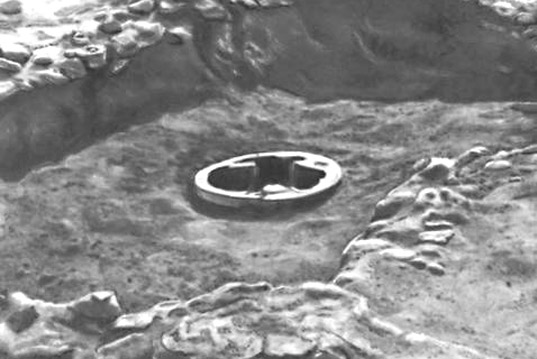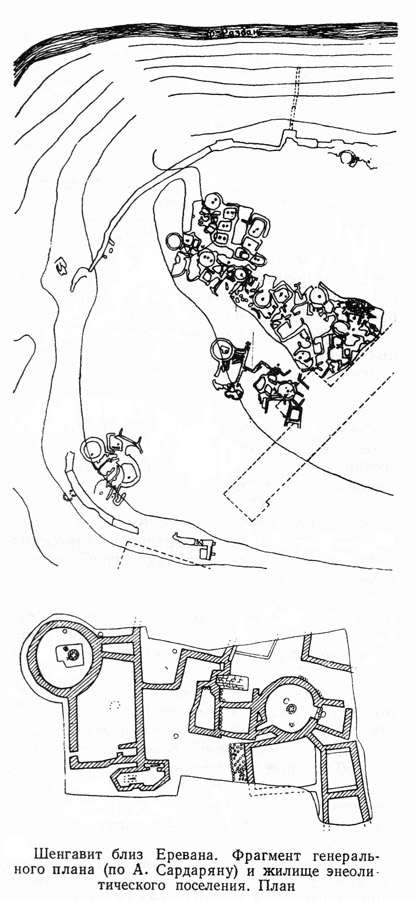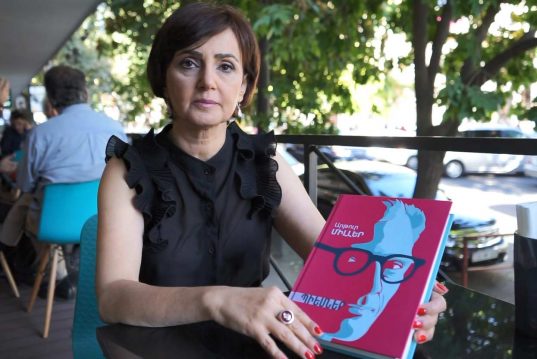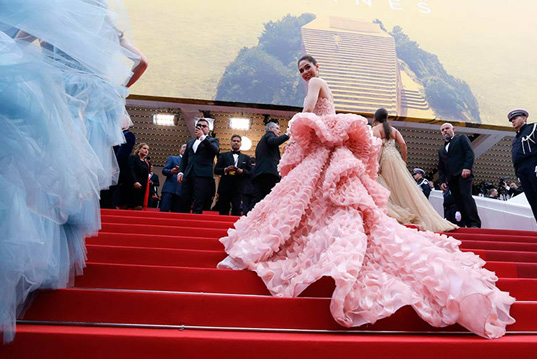The Shengavit settlement, which is located in the south-western part of Yerevan, on the left high bank of the river Hrazdan (nowadays east part of Yerevan lake) is one of the most prominent and relatively well studied monuments of Kura Araxes culture, Early Bronze Age. Shengavit’s settlement gives a complete picture of Early Bronze Age culture. During the excavations here four successive periods of ancient culture have been opened. These four (according to some researchers five) cultural layers are attributed to the 4-2 millenium BC. Though dating is contradictory in the vocational literature. In addition, the lowest layer is dedicated to the Chalcolithic (Eneolithic) period, and the other three layers to the culture of early Bronze Age. Sedentary lifestyle with developed agriculture, ranching and crafts, especially pottery and metalworking, is typical to the Shengavit culture. Materials discovered during the excavations speak about that. Shengavit’s settlement is known for its high developed architecture. Secular architecture, particularly residential buildings, as well as defensive, economic and spiritual buildings are significance. Shengavit’s settlement occupies an irregular-oval platform and has about 6 h area. It is an attached settlement, built on a slope. Shengavit has been surrounded by a wall with towers, which stonework is cyclopean, constructed of huge and uncut stones from basalt without mortar.  Under the wall, on the north side an underground passage has been discovered, which led to the river Hrazdan. And on the south side traces of filled moat are noticed. Shengavit’s wall with its towers, underground passage is one of the best defensive systems of its time. And it is presumable that the settlements of that period have been surrounded with defensive structures not only in Shengavit, were it is proved with research, but also in other hill-settlements.
Under the wall, on the north side an underground passage has been discovered, which led to the river Hrazdan. And on the south side traces of filled moat are noticed. Shengavit’s wall with its towers, underground passage is one of the best defensive systems of its time. And it is presumable that the settlements of that period have been surrounded with defensive structures not only in Shengavit, were it is proved with research, but also in other hill-settlements.
As the archaeologist H. Simonyan notices several features, incident to the old eastern cities, are typical to the Shengavit’s settlement. The principles of urban buildings and construction are noteworthy. Blocks for people of different professions: metallurgists, craftsmen and so on, have been formed in Shengavit with the conveniences of that time, about which the findings are evidenced. Houses, where people have lived, are of special interest. They have been found during the excavations from Early Bronze Age three layers. From the excavations of second layer discovered that the ancient inhabitants of Shengavit have lived in dwellings, which were round in their plan and have had 6-8 m diameter, and in rectangular structures, related to that dwellings. The houses were built on the foundation of the remnants of the houses of previous cultural layer. Their walls have had stone base, on which raw brickwork increased.  Mobile hearths (the floor of a fireplace, in Armenian ojax) are noteworthy, which were usually placed in the center of the house. They were made of clay, round, decorated and have mostly had horseshoe-shaped pedestals. Ojax has had both economic and ritual functions and was a symbol of the success of family. A huge stone pedestal with smooth surface has been put beside the ojax. That stone, anchor, kept the central pillar, on which the roof was rest. The roof was conical and made of rods and reeds. It reminds us the archaic shelter (so called Hazarashen), typical for Armenia. Unlike the round dwellings, the rectangular buildings have had smooth roofs. And the walls of that rectangular rooms were made of rubble, raw bricks on it. But some rooms are also met, where only raw brick is used. The walls of both round dwellings and rectangular buildings from inside and outside were plastered with clay. The round dwellings have had corridor-entrance. The entrance was mostly opened from east side. It sometimes has had stone doorstep. The floors of the dwellings were covered with rubbles. Corresponding to the circle of the round dwellings, benches and mats were made of raw brick inside. During the archeological excavations large and small wells of economic meaning and probably for grain keeping were opened. Although Shengavit’s round dwellings with the complex of rectangular rooms were found at a distance of 7.3 meters from each other, they were united with the last wall of the adjacent buildings. The above mentioned shows the high developed degree of Shengavit architecture.
Mobile hearths (the floor of a fireplace, in Armenian ojax) are noteworthy, which were usually placed in the center of the house. They were made of clay, round, decorated and have mostly had horseshoe-shaped pedestals. Ojax has had both economic and ritual functions and was a symbol of the success of family. A huge stone pedestal with smooth surface has been put beside the ojax. That stone, anchor, kept the central pillar, on which the roof was rest. The roof was conical and made of rods and reeds. It reminds us the archaic shelter (so called Hazarashen), typical for Armenia. Unlike the round dwellings, the rectangular buildings have had smooth roofs. And the walls of that rectangular rooms were made of rubble, raw bricks on it. But some rooms are also met, where only raw brick is used. The walls of both round dwellings and rectangular buildings from inside and outside were plastered with clay. The round dwellings have had corridor-entrance. The entrance was mostly opened from east side. It sometimes has had stone doorstep. The floors of the dwellings were covered with rubbles. Corresponding to the circle of the round dwellings, benches and mats were made of raw brick inside. During the archeological excavations large and small wells of economic meaning and probably for grain keeping were opened. Although Shengavit’s round dwellings with the complex of rectangular rooms were found at a distance of 7.3 meters from each other, they were united with the last wall of the adjacent buildings. The above mentioned shows the high developed degree of Shengavit architecture.
Shengavit burial places are of great interest, which were discovered outside the settlement’s walls. The existence of the burial places outside the walls is explained in the following way: according to one of the views, in the stage of its development Shengavit occupies greater space than it is assumed.
Later, for some reasons, slumping, it has been compressed with the walls, and the abandoned area has become a burial place. It is also assumed that the abandoned suburb has been populated in the 1st quarter of the 3rd millennium B.C. After the abandoned, in the 2nd quarter of the 3rd millennium B.C., a burial place was formed. Dozens of people were buried in each excavated tomb, which supposes that they are ancestral tombs of families, where not only the skeleton, but also the bones of sacrificed animals and burial property: stone tools, bronze goods and a pieces of pottery, has been found. Polished black clay pots, mugs, beads of carnelian and jasper, arrowheads of flint and obsidian, cupper armlets, earrings and etc. have been put with the dead. The study of the molds of the founded tombs shows that the “owners of the tombs belong to the round short-scull anthropological type”. Founded and recovered sculls correspond with the Armenoid anthropological type, spread in Armenian Highlands. The archaeological excavations, made in 2005, allowed the researchers to make the following observations: the body and the burial goods were put smooth, perhaps on the floor of the house, on the 50 cm depth of the ground present-day level. The tombs have had a rectangular composition. Based on the location of the bones, the researchers concluded that, according to the burial ritual, corpse partition has been made and the dead were buried side by side on a highly contracted position.
Continued …
Sourses:
- Եսայան Ա., Հայաստանի հնագիտությունը, Երևան, 1992:
- Խանզադյան Է., Հայկական լեռնաշխարհի մշակույթը մ.թ.ա. 3-րդ հազարամյակում, Երևան, 1967:
- Սարդարյան Ս., Նախնադարյան հասարակությունը Հայաստանում, Երևան, 1967:
- Սիմոնյան Հ, Շենգավիթի շերտագրությունը, շինարարական և կառուցապատման սկզբունքները: Հայաստանի հնագույն մշակույթը, 2 ⁄ Է. խանզադյանի հոբելյանին նվիրված գիտաժողովի նյութեր ⁄ , Երևան, 2002:
- Սիմոնյան Հ., Շենգավիթի դամբարանադաշտը, Հին Հայաստանի մշակույթը, 14, Երևան, 2008 ⁄ Նյութեր հանրապետական գիտական նստաշրջանի, նվիրված Բ. Պիոտրովսկու և Հ. Ջանփոլադյանի հիշատակին ⁄ :
- Սիմոնյան Հ., Խաչատրյան Լ., Շենգավիթ բնակավայրի 2003 թ. պեղումները, Հին Հայաստանի մշակութը, 13, Երևան, 2005 ⁄ Նյութեր հանրապետական գիտական նստաշրջանի ⁄ :
- Байбуртян Е., Последовательность древнейших культур Армении, На основании археологического материала, Рукопись, Архив Института археологии и этнографии – НАН РА, Ереван, 1939.
- Кушнарева К. Х., Марковин В. И., Эпоха бронзы Кавказа и Средней Азии. Ранняя и средняя бронза Кавказа, Москва, 1994.








Leave a Reply